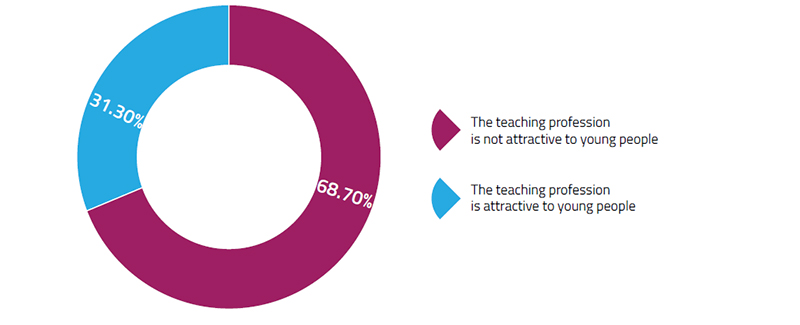By choosing this year’s theme to be “Young teachers: the future of the profession”, the World Teachers’ Day’s co-convening agencies wish to address one of the issues that has been plaguing the profession for some time now: how can the teaching profession attract and retain young, bright talents in the profession?
The global education goal, SDG 4, calls on countries to ensure that children are not only going to school but also learning, yet the proportion of teachers that are trained has been falling since 2000, especially in sub-Saharan Africa. Even more worrisome, new projections by the UNESCO Institute for Statistics (UIS) and the Global Education Monitoring (GEM) Report found that, at current trends, learning rates are expected to stagnate in middle-income countries, and drop by one-third in Francophone African countries by 2030. This would leave 20% of young people and 30% of adults still unable to read by 2030.
To turn these worrying trends around, we must invest in teachers, their education and professional development.
The reality of teaching
To get the real picture of teachers’ current training and working conditions, the Teacher Task Force collaborated with UIS and the GEM Report to produce a fact sheet giving the latest data on the global indicator for the Teacher Target.
Every learner has the right to be taught by a trained and qualified teacher. Unfortunately, this is not a reality for all of them. In Sub-Saharan Africa, only 64% of teachers were trained according to national standards at primary level in 2018-17. This share falls to 50% at secondary level. Comparatively in 2005, these figures had gone up to 71% and 79% respectively.
The share of trained primary school teachers has also fallen in Southern Asia, where it has gone from 78% in 2013 to 72% in 2018.
To teach efficiently, teachers need decent working conditions, like having electricity or sanitation facilities in schools. However, in Sub-Saharan Africa, only 34% of primary schools had access to electricity and 44% had access to basic drinking water in 2018-17. To make matters worse, 1 in 4 primary school did not have single-sex basic sanitation facilities in low-income countries.
To the issue of training and working condition plaguing the profession is the additional fact that the teaching profession also suffers from a poor image and status. Compared to jobs requiring similar qualifications, teaching often offers lower salaries for the responsibility and the amount of work required.
This leads to teachers leaving the profession in high numbers without enough new recruits to replace them, especially young new teachers.
Missing: young teachers
The future of society depends on the future of education. We need young teachers willing to take on the challenges of tomorrow.
Indeed, attracting young candidates to the teaching profession is a major challenge worldwide, and this is not just a supply issue. The hardships and obstacles affecting the profession disproportionately affect young teachers.
In their latest Education at a Glance report, the Organisation for Economic Cooperation and Development (OECD) reports that young teachers, defined as under 30 years old, make up a small proportion of the teaching population in their member states. Indeed, teachers under 30 account for 13% in primary education, 11% in lower secondary and 8% in upper secondary on average across OECD countries in 2017.
Keeping young teachers in the profession is also a critical concern. Student teachers often indicate the experience of facing their first classroom as the most daunting part of their job. This leads to high attrition rates in this age group. Solid teacher education and induction practices, as well as peer mentoring have been highlighted as models that could offer young teacher the support they need in their first years in the profession.
A problem without solutions?
The main concerns around the attractiveness of the teaching profession could be addressed in teacher policies developed as presented in our Teacher Policy Development Guide.
Indeed, in the guide are listed nine dimensions that we believe essential to address the current issues facing the profession. Among these dimensions, we list training and education, working conditions and remuneration as mandatory component of any policy pertaining to teachers.
It is our belief that tackling the problem of attracting and retaining young people in the teaching profession will require sound and holistic teacher policies developed with the input of a broad range of stakeholders, including young people themselves.
Held annually on 5 October, World Teachers’ Day commemorates the anniversary of the adoption of the 1966 ILO/UNESCO Recommendation concerning the Status of Teachers. This Recommendation sets benchmarks regarding the rights and responsibilities of teachers and standards for their initial preparation and further education, recruitment, employment, and teaching and learning conditions.
